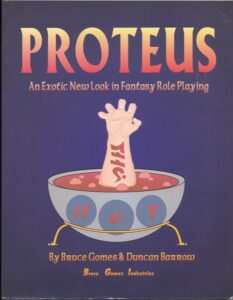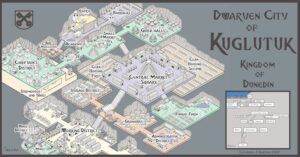Look what I found at Gothcon!

It’s a Fantasy Heartbreaker I did not know about. Special credit to the guy naming his imprint basically as himself, and special heartbreak for developing a line of lead miniatures which you can order by mail.
It was published in 1992, which puts it right in there with Legendary Lives, Of Gods and Men, Hahlmabrea, and Darkurthe Legends, and it sure fits, in many of the best ways. All its energy and enthusiasm are clearly from play … and you can play rats, including wizard rats.
Details which may vary in interest by reader:
- d10s and d6s are used in generating characters, but the only die used in play is 1d30, which gets a hell of a workout.
- Human characters’ ethnicity and culture is reasonably interesting, especially the group who are very much black Africans with gunpowder and unique mental magical disciplines.
- Magic is evidently mutagenic.
I don’t suppose anyone is surprised that I had to play this immediately, and Figo, Johan, and Helma were kind enough to accept jumping in without anyone being very clear about the rules.
I chose the nifty location called Trench and found some here-and-there on-the-internet pictures to use for it, if you pretend that the grassland or whatever that it is, is ocean:

The main community is underground and this map was well-suited to it.

Here are my preparation notes for the first, second, and third sessions.
Here are the character sheets, created from scratch for Helma/Rhena, and conceived and begun by me for four characters, two of which were chosen and completed by Figo and Johan. Or rather, in all cases, partly so, as more has been filled out on the fly during play. They’ll be completed as we continue. To forestall confusion, a “season” is two Earth years.
I’ve noticed that our brisk and inspiring play of Fantasy Heartbreakers, as indicated by site posts, fell off a while ago. This is both sad and bad. Let’s get back to it!


3 responses to “Magic, mutants, rats, guns”
I wonder how the recapitulation of Stats/Ability Scores / Attributes affects design decisions? Even today stats feel like a reactive thing in design by mirroring, manipulating, minimizing, or flat out rejecting the stats of older designs. And I don’t think we ever get the mental ones right. Fortitude looks especially tortured and Coordination too.
But that is the charm of a Heartbreaker.
From what I have watched so far, it seems the strong setting is a benefit to play?
Answering the final question first. The term or concept of “the setting” is too crude to be useful. I’ll try to be un-pedantic and to answer clearly.
The text-based setting is best described as playfully stupid. I think this is a good thing. I also think it is exactly the same for all the best role-playing texts which feature setting content, and for most revered fantasists in both literary and pop culture terms: Lewis, Tolkien, Dunsany; Howard, Smith, Leiber, Moorcock, LeGuin … and so on and on, name whomever you want.
The question is whether local spots and situations evoke resonance for me, either from the content as such or from some aspect of the way it’s presented which indicates an opinion on the author’s part. In literature, this is synonymous with “where the story is,” and is easily confounded, for the reader, with some notion of a big setting. You don’t see the process/difference between the two unless you get a little bit scholarly.
In role-playing, the relationship is more of an experienced process. As I said in the video, it tends not to jump out from the text immediately but takes some attention in reading, but especially application in play.
Furthermore, critically, it is not possible to tell whether the resonance is genuinely complementary between the text (author) or me. For example, if I were to meet the author of Undiscovered and enthuse to them how powerful the Dusters’ ethnicity is for play, pointing to what seems to me to be a textual wealth of intelligent detail and context, I might receive equally enthusiastic joy that “I got it” … or a puzzled stare because they just grabbed some tropes and something they thought was weird from biology class, and never saw the Dusters any differently from the comparatively bland and meaningless other races in the text.
I carefully documented my experience in this for Undiscovered and Legendary Lives, with many posts and comments here. I think contrary examples may be found in Fifth Cycle and Forge: Out of Chaos, which both provide the “playfully stupid” but for me have not sparked resonance for any imaginable play-location … but then again, I have played neither of them, and I’m willing to be surprised when that happens.
I hope this makes some sense. Let me know.
The desire to make sense out of earlier descriptive features (characteristics, attributes, whatever we call them) and to apply them directly into character function is as old as the hobby/activity. But you’re right that picking up something that didn’t really work and trying to make it work is one of the self-assigned jobs for a lot of designers.
In this case, I think RuneQuest is probably the main influence, and I recall your comment in the Patreon that the inherent logic in that game’s attributes-to-skills method is attractive. I think this author agrees and has taken it pretty far. You add all the attributes assigned to that skill, and divide the sum by 5, and that’s the base. Then you add the Familiarity associated with that skill, which may vary according to race or region, and then you add character points to reach the total you want.
It’s a lot of labor to arrive at units for a d30 roll, but not outrageously so, especially considering the late 80s state of the art games like Rolemaster and Fantasy Hero.